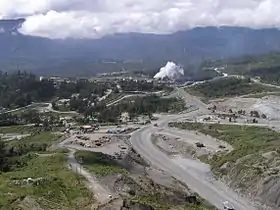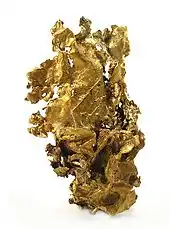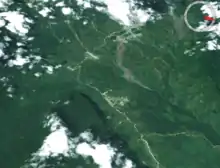Porgera Gold Mine
The Porgera Gold Mine is a large gold and silver mining operation in Enga province, Papua New Guinea (PNG), located at the head of the Porgera Valley. The mine is situated in the rain forest covered highlands at an altitude of 2,200 to 2,700 m, in a region of high rainfall, landslides, and frequent earthquakes.[1]
 Looking out across the lower half of the Porgera processing plant, and down into the Porgera valley | |
| Location | |
|---|---|
 Porgera Gold Mine Location in Papua New Guinea | |
| Province | Enga |
| Country | Papua New Guinea |
| Coordinates | 5°27′53″S 143°06′17″E |
| Production | |
| Products | Gold, Silver |
| Production | 572,600 ounces gold, 94,764 ounces silver |
| Financial year | 2009 |
| History | |
| Opened | 1990 |
| Owner | |
| Company | Porgera Joint Venture (PJV): 95% Barrick Gold, 5% Mineral Resources Enga (MRE) |
| Website | Barrick Gold Corp Website |
The Porgera Gold Mine is operated by the Porgera Joint Venture (PJV). It began production in 1990 and was developed and operated by Placer Dome which was acquired in 2006 by Barrick Gold, the world's largest gold mining company at that time. Emperor Gold Mine, holding a minority stake of 20%, sold to Barrick in April 2007. This gave Barrick (Niugini) a 95% ownership of the operation. The remaining 5% is owned by Mineral Resources Enga (MRE), which is owned by the Enga Provincial Government, the Papua New Guinea National Government and the Porgera Landowners Association. Barrick Gold Corporation and Zijin Mining Group each own 50% of Barrick (Niugini) Ltd.
Porgera Gold Mine is the second largest mine in Papua New Guinea and is regarded as one of the world's top ten producing gold mines. In 2009 it produced 572,595 ounces of gold and 94,764 ounces of silver and had 2,500 employees and 500 contractors. Since it began operating, the mine has produced more than 16 million ounces of gold and almost 3 million ounces of silver, accounting for about 12 percent of Papua New Guinea's total exports. The mine's proven and probable mineral reserves as of 2009 amount to 8.1 million ounces of gold.
Porgera Gold Mine is controversial. It has consistently been criticised for environmental and human rights issues. Its own internal investigations have revealed that killings, brutal gang rapes and beatings have been carried out by mine security personnel.
The mine
Porgera Gold Mine began operation in 1990. Originally an underground operation, open-pit mining became increasingly important after 1993, temporarily putting an end to underground mining in 1997. Since 2002 the mine utilises both open-pit and underground mining methods for ore extraction.[2] The site of the current open pit is Mt Waruwari which is being excavated.[3]
The open pit mine moves about 160,000 tonnes of rock material and gold-bearing ore per day, the underground mine over 2,000 tonnes.[4] Ore is processed in a mainly conventional plant, utilising several SAG and Ball mills, four Autoclaves, floatation cells and CIP / CIL. Gravity recovery is also used, Knelson concentrators doing the primary recovery, with an Acacia Reactor treating the concentrate. A large fleet of Cat 777 and Cat 789 trucks haul on the surface, fed by O&K shovels, and smaller excavators and loaders. A collection of underground development and production drilling equipment break ground, which is bogged by Elphinstone RH series LHD's into a fleet of Elphinstone AD45 trucks.[5] The mine is owned by Barrick Gold, a Canadian mining company.
Management and employees

4.7 x 2.8 x 1.6 cm
The mine is nominally a joint venture, however it is managed by Barrick Gold personnel, who are employed on a fly in fly out basis. As of July 2007, all departmental managers are of white extraction and are of non-PNG origin. None of the management team lives in the Porgera region, and all are accommodated in the mines camp facilities.
The mine has an extensive training and education program, and offers diverse traineeships and apprenticeships to local people. This has resulted in many people gaining the necessary skills for employment at the Porgera mine and at other mining operations in Papua New Guinea and other countries. In 2009, out of a total of 2,427 employees at the mine, 93.49% were PNG nationals, 1,606 were Porgerans, 33 other Engans, 630 other PNG nationals, and 158 were expatriates.[6]
Production
The mine was originally one of the world's major low-cost gold producers, but operating costs have increased.[1] In 2004 it produced over one million ounces of gold at a cash cost of US$192 per ounce.[2] Its output fell to about 865,000 ounces in 2005, and has reached 572,595 ounces of gold at cash costs of US$515 per ounce in 2009.[7] With its 2,500 employees and 500 contractors it is one of the largest gold mines in Papua New Guinea and Australasia, and is widely regarded as one of the world's top ten producing gold mines.[6]

| Year | Gold | Silver | Year | Gold | Silver | |
| 1990 | 265,890 ounces | 224,227 ounces | 2000 | 910,434 ounces | 110,276 ounces | |
| 1991 | 1,216,101 ounces | 593,312 ounces | 2001 | 760,622 ounces | 113,043 ounces | |
| 1992 | 1,485,077 ounces | 139,619 ounces | 2002 | 641,811 ounces | 126,772 ounces | |
| 1993 | 1,156,670 ounces | 129,860 ounces | 2003 | 851,920 ounces | 164,691 ounces | |
| 1994 | 1,032,768 ounces | 133,890 ounces | 2004 | 1,019,746 ounces | 185,336 ounces | |
| 1995 | 848,870 ounces | 90,770 ounces | 2005 | 867,925 ounces | 157,740 ounces | |
| 1996 | 854,822 ounces | 106,535 ounces | 2006 | 523,358 ounces | 104,238 ounces | |
| 1997 | 712,693 ounces | 100,479 ounces | 2007 | 513,177 ounces | 79,561 ounces | |
| 1998 | 726,806 ounces | 91,614 ounces | 2008 | 632,603 ounces | 90,610 ounces | |
| 1999 | 754,754 ounces | 100,694 ounces | 2009 | 572,595 ounces | 94,764 ounces | |
| Total 1990–2009 | 16,348,642 ounces | 2,938,031 ounces | ||||
Impact
The mine has had a large impact on its immediate local area. While modern health care and education services have been brought to the valley by the mine, and some members of the community have profited from the mine's presence;[8] alcoholism, lawlessness and illegal mining have all increased.[9]
Controversies
Civil unrest April – May 2007
On 23 April 2007 local landowner groups protesting over proposed relocation settlements were successful in peacefully halting mining and processing operations at the mine. The suspension lasted for 10 days, during which various local landowner clans, PNG government representatives and PJV mine management eventually reached a form of agreement on how best to move on.[10][11]
Human rights issues
The mine employs its own security force, numbering somewhere between 400 and 500 persons. Some sections of the security force are licensed to utilise lethal force. Police and security guards have killed 8 people (the company's figures) to 14 people (according to a community association) over the past ten years, and injured many more.[12][13] In 2009 rising insecurity around the mine led the government of Papua New Guinea to deploy several squads of mobile policemen to Porgera. According to Amnesty International, the deployment resulted in the eviction of nearby villagers and the burning of their houses.[14]
Human Rights Watch investigated and documented reports of abuse, including brutal gang rapes and beatings, carried out by security personnel at the mine. Barrick Gold, after having denied previous claims of crimes committed at the mine, launched an internal investigation which confirmed the findings.[9]

Environmental issues
The mine practises riverine tailings disposal, by which processed ore is dumped directly into the local river. This results in an increased sediment loading of approximately 8 million tonnes per year. Additionally, the mine has two 'Erodible Dumps' – areas where soft waste rock are dumped and the high amount of local rainfall gradually washes into the local rivers. The increase in sediment loading is hard to quantify, but is generally thought to be in the range of 4 to 6 million tonnes per year. The river systems eventually deliver hundreds of millions of tonnes of sediment into the Gulf of Papua.
The main concern with riverine tailings disposal as practised by the PJV is not the quantities of sediment, but the toxicity of the tailings, which contains significant quantities of cyanide, mercury and other heavy elements. The mercury is 'fixed' in a compound state by which it is thought it will not ultimately enter the food chain, but no conclusive research has been performed. However, the mine has been certified as fully compliant with the International Cyanide Management Code.[15]
The mine has also three vast dumps of waste rock—stone with quantities of gold ore too low to be processed economically.
In January 2009, Norway's finance ministry announced, that the Government Pension Fund of Norway excluded Barrick Gold from its investments, due to the “severe environmental damage” caused by the Porgera Gold Mine,[16] stating that “the company’s riverine disposal practice is in breach of international norms [and] the company’s assertions that its operations do not cause long-term and irreversible environmental damage carry little credibility [and that there is] reason to believe that the company’s unacceptable practice will continue in the future.”[17]
Local politics
The local body which was established to represent the landowners around the mine, the Porgera Landowners Association (PLOA), is funded by a percentage of royalties from the mine, receiving $1.4 million in 2009. However the PLOA refuses to publish its accounts, and many landowners accuse the leadership of the PLOA of lining their own pockets at the expense of ordinary landowners. As a result, the mine negotiates with individual landowners direct rather than through the PLOA as intended.[18]
Accidents
- In August 1994, eleven workers were killed when a blast destroyed the Dyno Wesfarmers explosives factory at the Porgera Gold Mine. The blast left a crater 40 meters wide and 15 meters deep, damaging property up to 2 kilometers away. The cause of the accident was never determined.[19]
- On 3 March 2012, five people were killed and at least one person was injured in a routine blast at the mine. Police said the victims had entered the mine illegally to search for gold. The three survivors were arrested and charged with trespassing.[20]
See also
References
- "Mining for the Future. Appendix I: Porgera Riverine Disposal Case Study" (PDF). Mining, Minerals and Sustainable Development, International Institute for Environment and Development (IIED). April 2002. Archived from the original (PDF) on 2011-10-01. Retrieved 19 April 2011.
- "Porgera Gold Mine, Papua New Guinea". mining-technology.com. 2006.
- Alexander Wanek (1996). The state and its enemies in Papua New Guinea. Curzon Press. p. 145. ISBN 0-7007-0304-7.
- "The Mine, its People and the Future" (PDF). Porgera Joint Venture (PJV). March 2009. Retrieved 26 April 2011.
- "Mining & Processing". Porgera Environmental Advisory Komiti's (PEAK). Retrieved 26 April 2011.
- "Information Booklet" (PDF). Porgera Joint Venture (PJV). 2009. Retrieved 26 April 2011.
- "Porgera Mine". InfoMine Inc. Retrieved 26 April 2011.
- PNG Industry News Wild times at PorgeraPNG Industry News, Retrieved 15-12-11
- "Gold's Costly Dividend. Human Rights Impacts of Papua New Guinea's Porgera Gold Mine". Human Rights Watch. February 2011. Retrieved 19 April 2011.
- "Villagers block off Porgera gold mine" The National 24 April 2007
- "Porgera resumes operations" Post-Courier 3 May 2007
- Saskatoon Star-Phoenix, Sunday, June 04, 2006 – Canadian mine in New Guinea 'a shooting field' – Papuan villagers killed scavenging for gold: company says they were often violent Archived May 30, 2009, at the Wayback Machine
- MiningWatch Canada, Newsletter 21: Saturday April 8, 2006 – Placer Dome Admits to Killings at Porgera Mine in Papua New Guinea
- Amnesty International, "Undermining Rights: Forced Evictions and Police Brutality Around the Porgera Gold Mine, Papua New Guinea," February 2010
- "Cyanide Management: Porgera, Plutonic gold mines certified". Canadian Mining Journal. 15 November 2009. Archived from the original on 21 July 2012.
- "To the Ministry of Finance. Recommendation of 14 August 2008" (PDF). Government Pension Fund – Global. 14 August 2008.
- "Press release: Mining company excluded from the Government Pension Fund – Global due to contribution to serious environmental damage". Ministry of Finance of Norway. 30 January 2009.
- Human Rights Watch (2010). "Gold's Costly Dividend" (PDF). Human Rights Watch. pp. 35–37.
- Inquiry Report Department of Mining and Petroleum, Government of Papua New Guinea 1994
- "Blast kills five trespassers at PNG gold mine". BNO News. 6 March 2012. Archived from the original on 15 July 2012. Retrieved 6 March 2012.
External links
| Wikimedia Commons has media related to Porgera Mine. |
- Barrick Gold Corp Website
- Porgera Environmental Advisory Komiti's (PEAK) website
- Health concerns from Porgera Mine
- Emperor Gold press release (PDF) on sale of stake to Barrick
- Len Murray, Mark Thompson, Malcolm Lane: Obstacles to On-Land Mine Tailings Disposal in Papua New Guinea. Klohn Crippen Berger Ltd., Lane Associates Ltd.
- Oxfam Mining Ombudsman Annual Report 2000–2001
- Gold’s Costly Dividend. Human Rights Impacts of Papua New Guinea’s Porgera Gold Mine. Human Rights Watch, February 2011
- Kelly Patterson: A deadly clash of cultures. A sprawling Canadian mine in Papua New Guinea has become a war zone, with hundreds of villagers facing off against more than 450 security guards and police in a bloody battle over the gold that lies on the slopes of the Porgera Valley. The Ottawa Citizen, 5 June 2006